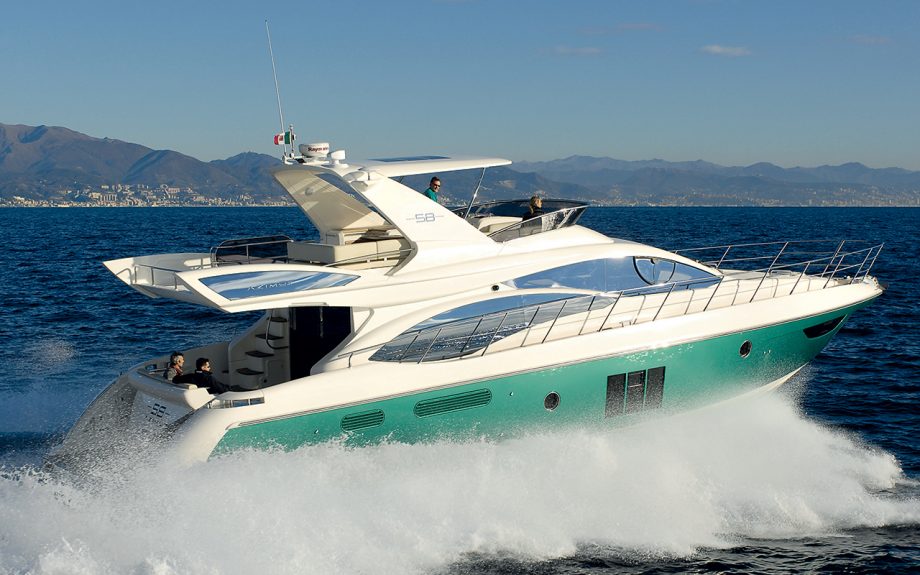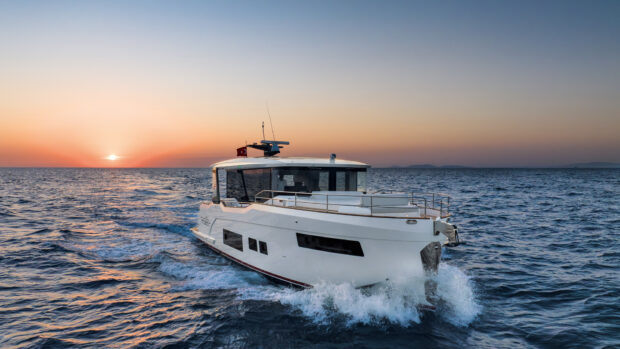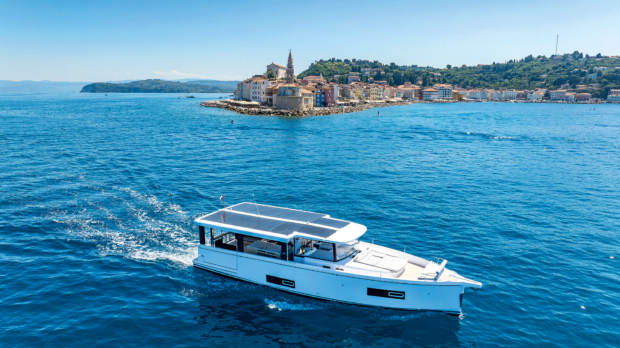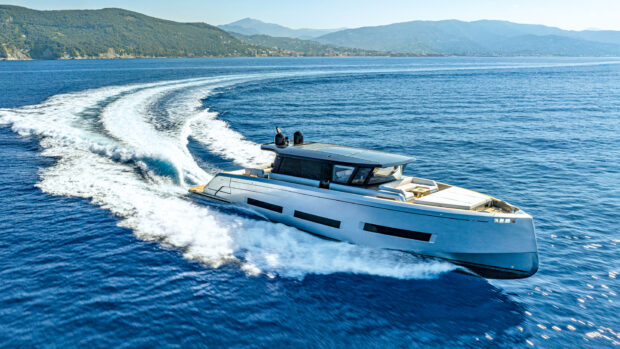This flybridge contender from Azimut boasts a stunning interior that feels the height of indulgent luxury, but the Azimut 58 is also packed with practical solutions inside and out.
These days, anybody who can afford to splash a million pounds or more on a flybridge boat is in for a treat. Around this price bracket, wonderful things start to happen inside.
A palatial full-beam owner’s cabin is a given nowadays – a new 60 footer lacking this decadent touch would probably be dead in the water. But that’s just the starting point for a remarkable variety of layouts.
The inside of the Azimut 58 is very much a tale of luxurious accommodation on different levels, which sets an immediate contrast with the flybridge boats from Ferretti, particularly the newest of its rivals, the 592.
This boat has a radically different solution with a saloon floor that runs through on one unbroken level.
Upstairs downstairs
A single-level saloon, with the galley adjacent to and open to the cockpit, as on the latest Ferrettis, makes a lot of practical sense
There are no steps to climb, the cook is always part of the action, and the galley can serve as an on-deck bar. But you lose a sense of privacy and cosiness.
Twice while the Azimut 58 was tied up, we visited the nearby café and brought coffee back on board, sitting and chatting around the comfy dinette.
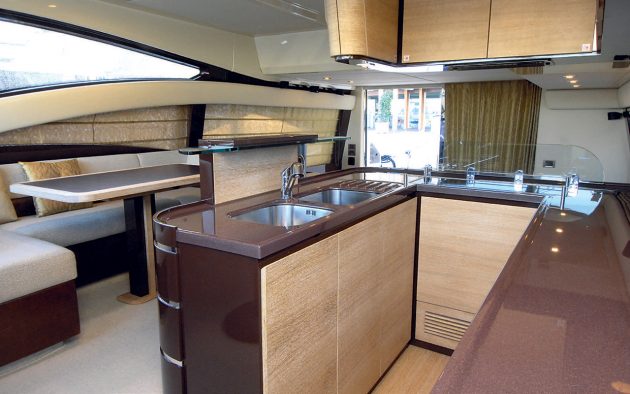
Probably the most practical galley-up we’ve encountered, with its generous countertop and reasonable stowage.
There was a lovely sense of social intimacy that I hadn’t felt on board the Ferretti 510 I’d tested the previous week.
The Azimut’s lower saloon offers a space to work or relax away from the others ‘up top’.
That, or any other private activity like the simple act of taking a phone call, would have been difficult in a more open-plan saloon.

Dinette-galley proximity makes life easy and sociable for the cook at meal times.
In a smaller boat the feeling of space at all costs is probably more crucial, but on this size of boat, with so much room on board, there are arguments in favour of breaking up the different spaces into more clearly defined areas.
Striding up two steps to the dinette, and one down to the galley, is hardly arduous.
And the fact that you are considering a flybridge boat, rather than a sportscruiser, suggests that single-level-living is not your overriding consideration.
Luxury and practicality
Whatever the pros and cons of Azimut’s layout, what grabbed my attention most when I first stepped on board and wandered around inside was the feeling of unbridled luxury.
It’s hard to quantify. Maybe it’s the lashings of real leather trim that Azimut use where you would expect to find fabric or maybe it’s the acres of solid limed oak woodwork.
In absolute terms, the Azimut 58’s joinery is no better finished than its rivals’ and they still use exposed glassfibre mouldings in several places, but it’s of such consistently outstanding quality that it only adds to the classy feeling.
Whatever the cause, the end result feels even more luxurious than normal.
Azimut must have hard-nosed accountants just like any other profitable boatbuilder, but I reckon that when Azimut’s interior designer Carlo Galeazzi is around, he locks them up and hides the key.
Luxury is one thing, but for a million pounds you’d expect more.
That extra something is impressive practical detailing in almost every area: and Azimut deliver.
Let’s start at the front. The scissor-action berths that Azimut introduced on their 62S appear here in the forecabin.

Scissor-action berths are versatile.
In single-berth form, with the berths resting outboard, the cabin feels huge because there’s so much floor space in the middle.
Swing the berths together though, then shuffle the mattresses and the covers into place (this takes about a minute) and, hey presto, a double.
So far, only Sessa have been bold enough to copy the idea, on their C46.
After seeing a cabin arranged like this though, it barely seems sensible to do it any other way, because it’s infinitely more flexible than the usual fixed double berth alternative, and yet has no obvious downside.
Further aft, Azimut have tried harder than most to squeeze every last drop of storage space into the full-beam owner’s cabin.

Good lighting in the owner’s suite at night plus plenty of natural light during the day.
Even the dressing table stool has a removable lid and a soft lining inside. The headroom here is fine, too: 6ft 3in (1.9m), the same as the length of the double berth.
The ensuite shower is huge – ample for two consenting adults – and the roomy heads sports a useful large laundry locker.
An area where so many Italian boats fall down is in the workings of the dash and the helm.
However, Azimut have excelled on the 58 with a fully adjustable electrical seat, and a wide and well-designed dash that rivals the practicality of the typically class-best helms of the British boats.

Big owner’s ensuite heads; the shower (off to right) is huge.
Outside, there is more impressive practical design on show. Azimut are one of the few boatbuilders who have kept most of their tall radar arches in the middle of their flybridges.
This is a significant bonus for anything mounted on the arch.
Equipment like the VHF, the searchlight, and most importantly the radar, all have a far better view over the boat and towards the horizon.
Some radars are sited so improbably low that they can’t even ‘see’ over the dash or the heads of children on the flybridge.

Probably as large a dash area as you can get on a 60-footer. There’s space for two big plotters, plus a small chart table to starboard.
So bonus points to the Azimut team for safety first.
The other benefit of the mid-mounted arch and hard top is the tangible feeling of safety and security it gives the flybridge.
No other rival’s flybridge boat around this size feels so protected.
That’s partly due to the good depth around the flybridge’s perimeter, but it’s also down to the sheltered feeling the hard top provides for the middle of the flybridge.
What else did I like? Well, the electro-hydraulic hi-lo bathing platform is probably not intended to be a safety feature, but if I lost crew overboard, forget about any quirky MOB contraptions – this is exactly what I’d want to get them back on board.
Coincidentally, it also makes light work of launching and recovering a tender or other watersports toys.
I still haven’t found any stern mooring arrangements I prefer.
Simple multi-angle rollers allow the lines to run out at any angle, and the large horn cleats are permanently exposed, so that lines can be coiled over them, ready for immediate use when you park in a hurry or short handed.

Split-level saloon feels cosy and luxurious. The seating is particularly comfortable.
Plus, there are no fiddly covers susceptible to damage.
Mind you, Azimut need to sort out their woeful side-boarding arrangements.
Azimut’s 43S delighted us with the invaluable side-doors set into the topsides of its cockpit, but this Azimut 58 has no such amenities.
This means a jump from the safety of the grippy teak platform, over the slippery corner mouldings and past the bulging stern fender.
It’s probably over a metre jump before you reach the pontoon.
Fine for athletic types on a dry day; not so prudent when your granny returns with the shopping bags on a rainy day.
Not everybody moors stern-to in a Med marina.
Driving the Azimut 58
There’s only one area where Azimut’s flybridge boats (the 58 included) fail to shine, and that’s handling
They can’t match the almost unbelievably sporty, razor-sharp handling of the best of the British boats.
Eyes closed, you would swear that the Azimut 58 is twice the size and double the weight of, say, a Princess 61 or a Manhattan 60.
The difference really is that great – think Range Rover versus Jaguar XK8. Does that matter? Well, only you know the answer.

The flybridge feels exceptionally safe and secure thanks to deep sides and mid-mounted radar arch.
Most Rangie drivers are doubtless happy with their lot, and how often do you drive a large flybridge cruising boat like an XK8? Maybe never – but it is fun!
In Range Rover mode though (in other words, cruising along), the Azimut 58 is excellent.
Both helm positions work well, especially the lower. Having space for two large radar/chart plotter displays is good for safety in case one fails, and the small chart table is an invaluable back-up too.
Two people could cuddle up on the seat alongside the helmsman, although it’s the driver that gets the best pew – a leather-clad throne, complete with just about every possible adjustment and option, barring full shiatsu massage (don’t snigger, it’s standard on the Lexus LS600h at a fraction of the Azimut 58’s price).
Upstairs or down, the view out is excellent. Azimut tint windows and screens, but only ever so lightly, and most of the obscurity comes from the mirrored finish on the outside. The result is class-best privacy for those inside, but still a very clear, safe view out for the helmsman and crew, something that many Med-based builders are inclined to disregard.
On a cool, beautiful day in December, in the waters around Savona in Northern Italy, the 800hp MAN engines pushed our Azimut 58 to a comfortable 32.0 knots.
Even at this speed, the 58 feels relaxed, and it felt at ease cruising quickly around 27 knots.
The combination of good performance and two comfortable and well-designed helm positions make it an easy-going boat to cruise.
The only uncomfortable aspect was the relentless squeaking coming from the fibreglass window mouldings inside, on the port side.
No doubt Azimut will cure this (ours was the prototype 58) but do check – you wouldn’t be able to endure it for long without the help of Led Zeppelin playing on Azimut’s ingenious iBoat thingy – essentially an iPod docking system that connects to the Azimut 58’s audio system.
Engineering and construction of the Azimut 58
Azimut’s philosophy has long been to offer just one engine option – of their 15 flybridge boats under 100ft, only two have a second engine option.
As long as the engines suit the boat and give good performance, which they invariably do, I reckon it’s a great idea.
This standardisation is better for engineering back-up should things go wrong, and the design team can locate everything in the engineroom in the optimum place for service accessibility.
It means, too, that all the daily service items are easy to get to, even if you’re portly.
There’s a whole bunch of useful practical details down here.
There are two lights on long wandering leads, which are ideal for illuminating those otherwise shadowy places.
A big diverter valve on the raw-water intake allows the engine to be used as a giant emergency bilge pump, drawing water from your flooding engineroom instead of the sea – a great safety feature.
Both engines have large interchangeable fuel filters, with clear bowls that allow a reassuring daily check.
There’s a fresh-water hose for topping up the water or for cleaning, and the steps into the engineroom have non-slip plastic treads, not slippery stainless bars as many do.
There are only a few details that would benefit from change. Strangely, only one fuel tank has a drain cock for removing dirty deposits from the bottom of the tank.
Likewise, there’s only a single fuel-level sight gauge.
If disaster does strike and you are forced to run on one tank, this is surely the time when you need to check the fuel level most diligently, and for that you need separate sight gauges on each tank.
And the batteries would be safer if the battery box lid had webbing tie-downs.
Otherwise, this is a fine, practical, accessible and well.thought-out engineering installation.
Azimut 58 verdict
The biggest surprise in writing this report has been finding how often the issue of safety cropped up.
It’s the sort of thing you expect to read about in a Grand Banks or a Nordhavn test, but not in the pages of a report on a glamorous flybridge boat.
Yet Azimut have conspired to produce a mainstream flybridge cruiser that scores highly on the safety front.
Most of this comes courtesy of sound design; the deep, sheltered flybridge is a good example.
Some of it, the ability to safely recover a man-overboard using the hi-lo bathing platform for instance, is probably more safety byproduct than specific intent. Either way, it’s all very welcome.
Beyond this surprise, it’s business as usual for Azimut.
And that’s very good news. Dig beyond the obvious glamour and you will find a strong practical streak running through the Azimut 58.
It’s not focused in just one area: the decks, the accommodation and the engineroom all exhibit signs of sound, practical thinking.
Azimut’s designers either spend time on the water, or they know somebody who does.
If you are a fan of the sporty handling that the big British flybridge boats provide, you may not consider the Azimut 58 to be the consummate flybridge cruiser.
Whether you actually need an aquatic version of a Jaguar XK8 is another matter.
Just bear in mind that the Azimut 58 is more luxury limo than nimble roadster, and you won’t be disappointed.
Whatever your specific likes and dislikes in the style department, I defy anybody to dispute the wonderful feeling of no-expense-spared opulence that pervades the interior of the Azimut 58.
Carlo Galeazzi has again worked his magic on the interior design.
There may be other production flybridge boats around this size and price whose boatbuilders have spent far more furnishing their interiors, but I’ve yet to find one that feels that way.
First published in the March 2008 issue of MBY.
Pros
- No-holds-barred luxury
- Fine practical detailing
- Deep, safe flybridge
- Scissor-action forward berths
- Lower helm and dash area
- Engineering installation
- Hi-lo bathing platform
- Optional bimini top
- Stern mooring gear set-up
- Resin-infused hull
Cons
- Squeaky fibreglass trim
- Side-boarding access
Price as reviewed:
£980,000.00
Details
Overall length: 58ft 8in (17.88m)
Beam: 16ft 3in (4.95m)
Displacement: 23.5 tonnes light, 26.5 tonnes loaded (loaded = light + 100% fuel & water)
Draught: 4ft 6in (1.37m)
Air draught: 17ft 2in (5.24m)
Fuel capacity: 616 imp gal (2,800 litres)
Water capacity: 143 imp gal (650 litres)
Price from: £980,000 inc UK VAT (twin 800hp)
Designers: Stefano Righini & Carlo Galeazzi, 2007
RCD category: B (for 14 people)
Contact: Opal Marine
Tel: +44 (0)1234 511381
Email: azimut@opalmarine.com
Website: www.azimutyachts.net


